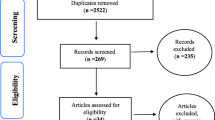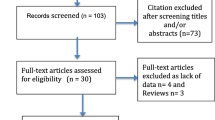Abstract
Context
Anal incontinence is increasingly being recognised as a significant cause of physical and psychological morbidity with implications for healthcare provision within the community. There is controversy about which population groups are most disadvantaged by this chronic condition.
Objectives
The aim of this study was to evaluate the prevalence of this condition in the community according to age and gender, a systematic review was performed. Data sources: Data were from Embase, Medline, bibliographies of known articles and contact with experts.
Study selection
Studies were selected if data on anal incontinence could be extracted for participants over 15 years of age and living in the community.
Data extraction
Data were extracted using a piloted form on participants' characteristics, study quality and incontinence rates.
Data synthesis
Meta-analysis was used to combine data from multiple studies, and meta-regression evaluated the variation in rates according to age and gender in an analysis adjusted for study quality.
Results
There were 29 studies (69,152 participants), of which 5 met over half of the high quality criteria. The rate of solid and liquid faecal incontinence among people aged 15–60 years was 0.8% [95% confidence interval (CI) 0.3–1.9] in men and 1.6% (95% CI 0.8–3.1) in women. In those aged over 60, this increased to 5.1% (95% CI 3.4–7.6) in men and 6.2% (95% CI 4.9–8.0) in women. Meta-regression showed that age had a significant influence on rates of solid and liquid faecal incontinence (p=0.007), but not gender (p=0.368) or study quality (p=0.085).
Conclusions
The rate of solid and liquid faecal incontinence in older people is significantly higher than their younger counterparts. Gender differences in rates did not reach statistical significance.



Similar content being viewed by others
References
Norton C, Christiansen J, Butler U, Harari D, Nelson R, Pemberton JH et al (2002) Anal incontinence. In: Abrams P, Cordozo L, Khoury SE, Wein AJ (eds) Incontinence—report of the second World Health Organisation international consultation on incontinence. Publication Ltd., Plymouth
Gilleard CJ (1980) Prevalence of incontinence in local authority homes for the elderly. Health Bull 38:236–238
Jagger C, Clarke M, Davies RA (1986) The elderly at home: indices of disability. J Epidemiol Community Health 40:139–142
Brocklehurst JC (1972) The problems in old age. Proc Roy Soc Med 65:66–69
Diokno AC, Brock BM, Herzog AR, Bromberg J (1990) Medical correlates of urinary incontinence in the elderly. Urology 36:129–138
Drossman DA, Li Z, Andruzzi E, Temple RD, Talley NJ, Thompson WG, Whitehead WE, Janssens J, Funch-Jensen P, Corazziari E, Richter JE, Koch GG (1993) U.S. householder survey of functional gastrointestinal disorders: prevalence, sociodemography, and health impact. Dig Dis Sci 38:1569–1580
Edwards NI, Jones D (2001) The prevalence of faecal incontinence in older people living at home. Age Ageing 30:503–507
Roche B, Chautems R, Rakotoarimanana R, Deleaval J, Berclaz O, Marti M-C (2002) Epidemiologie de l'incontinence anale. Rev Med Suisse Romande 122:71–74
Enck P, Bielefeldt K, Rathmann W, Purrmann J, Tschope D, Erckenbrecht JF (1991) Epidemiology of faecal incontinence in selected patient groups. Int J Colorectal Dis 6:143–146
Lam TCF, Kennedy ML, Chen FC, Lubowski DZ, Talley NJ (1999) Prevalence of faecal incontinence: obstetric and constipation-related risk factors: a population-based study. Colorectal Dis 1:197–203
MacLennan AH, Taylor AW, Wilson DH, Wilson D (2000) The prevalence of pelvic floor disorders and their relationship to gender, age, parity and mode of delivery. Br J Obstet Gynaecol 107:1460–1470
McKibbon A, Eady A, Marks S (1999) Identifying and selecting studies for inclusion. PDQ evidence-based principles and practice. BC Dekker, Hamilton, pp 125–127
Glasziou P, Irwig L, Bain C, Colditz G (2001) Using the quality appraisal. Syst Rev Health Care Part 1:27–29
Glasziou P, Irwig L, Bain C, Colditz G (2001) Frequency and rate. Syst Rev Health Care Part 2:67–73
Streiner DL, Norman GR (1995) Health measurement scales. Oxford University Press, Oxford
Laird NM, Mosteller F (1990) Some statistical methods for combining experimental results. Int J Technol Assess Health Care 6:5–30
DerSimonian R, Laird NM (1986) Meta-analysis in clinical trials. Control Clin Trials 7:177–188
Egger M, Davey Smith G, Schneider M, Minder C (1997) Bias in meta-analysis detected by a simple, graphical test. BMJ 315:629–634
Eva UF, Gun W, Preben K (2003) Prevalence of urinary and fecal incontiennce and symptoms of genital prolapse in women. Acta Obstet Gynecol Scand 82:280–286
Faltin D, Sangalli MR, Curtin F, Morabia A, Weil A (2001) Prevalence of anal incontinence and other anorectal symptoms in women. Int Urogynecol J 12:117–121
O'Keefe EA, Talley NJ, Zinsmeister AR, Jacobsen SJ (1995) Bowel disorders impair functional status and quality of life in the elderly: a population-based study. J Gerontol 50A:M184–M189
Roberts RO, Jacobsen SJ, Reilly WT, Pemberton JH, Lieber MM, Talley NJ (1999) Prevalence of combined fecal and urinary incontience community-based study. J Am Geriatr Soc 47:837–841
Walter S, Hallbook O, Gotthard R, Bergmark M, Sjodhal R (2002) A population-based study on bowel habits in a Swedish community: prevalence of faecal incontinence and constipation. Scand J Gastroenterol 8:911–916
Stroup DF, Berlin JA, Morton SC, Olkin I, Williamson GD, Rennie D, Moher D, Becker BJ, Sipe TA, Thacker SB (2000) Meta-analysis of observational studies in epidemiology. JAMA 283
Deeks J, Khan KS, Song F, Popay J, Nixon J, Kleijnen J (2001) Undertaking systematic reviews of research on effectiveness. NHS Centre for Reviews and Dissemination 4:9
Sultan AH, Kamm MA, Hudson CN, Thomas JM, Bartram CI (1993) Anal sphincter disruption during vaginal delivery. N Engl J Med 329:1905–1911
Acknowledgements
The authors acknowledge Mary Publicover, Librarian, Birmingham Women's Hospital, for the written permission to submit this article and for her advice on the search strategy; Augustus Newman Fund from Royal College of Surgeons and Research and Development Committee at Birmingham Women's Hospital.
Author information
Authors and Affiliations
Corresponding author
Electronic supplementary material
Below is the link to the electronic supplementary material.
Rights and permissions
About this article
Cite this article
Pretlove, S.J., Radley, S., Toozs-Hobson, P.M. et al. Prevalence of anal incontinence according to age and gender: a systematic review and meta-regression analysis. Int Urogynecol J 17, 407–417 (2006). https://doi.org/10.1007/s00192-005-0014-5
Received:
Accepted:
Published:
Issue Date:
DOI: https://doi.org/10.1007/s00192-005-0014-5




